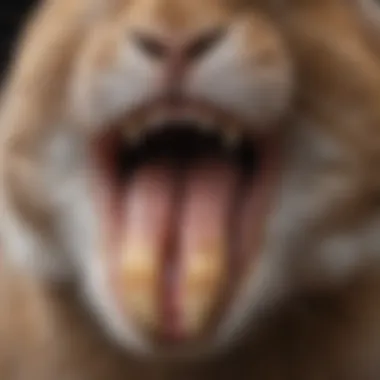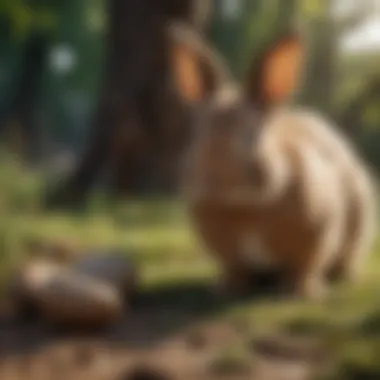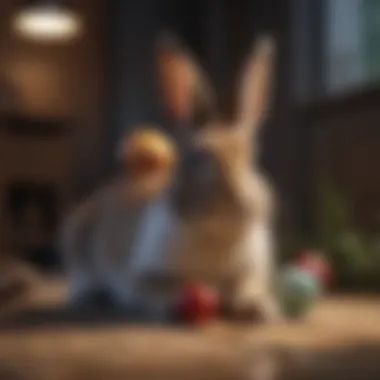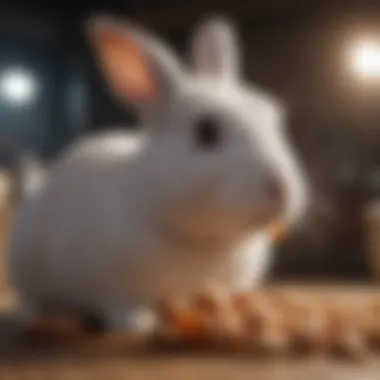Understanding Rabbit Chewing Behaviors for Optimal Care


Intro
Chewing is a fundamental behavior for rabbits that serves various crucial purposes. Understanding this aspect can notably enhance their health and well-being. This section aims to outline essential elements related to rabbit chewing habits, including their significance in maintaining dental health and fostering engagement with their environment.
Rabbits feature continuously growing teeth. Without proper chewing opportunities, they can develop dental problems that may lead to pain or difficulty in eating. By providing suitable materials and ensuring a varied diet, pet owners can promote a healthy chewing behavior, reducing the risk of these issues.
Moreover, chewing is innate to a rabbit's instinctual needs. It provides mental stimulation, preventing boredom. This article will explore how different materials impact chewing, the psychological benefits of this behavior, and practical solutions to cater to your pet's needs.
Understanding Your Pet
Pet Behavior Basics
Rabbits display a range of behaviors influenced by their environment, instinct, and individual characteristics. Recognizing these behaviors is essential for any pet owner. Chewing is not just about eating; it also involves exploration and comfort. A rabbit's chewing habits can indicate their emotional state, curiosity, or even anxiety.
Common Breed Characteristics
Various rabbit breeds exhibit distinct chewing behaviors. Larger breeds, like the Flemish Giant, may enjoy chewing on larger items, while smaller breeds, such as the Netherland Dwarf, may prefer toys suited to their size. Understanding these breed characteristics can guide pet owners in selecting appropriate materials for enrichment.
Species-Specific Needs
It's important to recognize that rabbits have unique needs compared to other pets. They require specific types of chewing materials to avoid dental issues. Safe options include untreated wood, paper products, and hay. Avoid using anything treated with chemicals. Additionally, they thrive on companionship and can benefit from social interactions with other rabbits or attentive owners.
Chewing Materials
When selecting suitable chewing materials, consider quality and safety. Here are different categories:
- Natural Wood: Safe, non-toxic woods (like apple or willow) provide great textures.
- Hay: An essential part of their diet, hay encourages chewing and offers fiber for digestive health.
- Cardboard and Paper: These can entertain and satisfy instinctual chewing.
- Store-bought Chews: Ensure they are free from harmful additives.
Benefits of Chewing
Engaging in chewing offers multiple benefits:
- Dental Health: Helps wear down teeth properly.
- Behavioral Satisfaction: Redirects negative behaviors that stem from boredom.
- Nutritional Value: Chewing hay is an important dietary requirement, stimulating digestion.
Epilogue
Understanding rabbit chewing behaviors is essential for promoting their health and happiness. By aligning your approach with their natural instincts, you contribute to their overall well-being. The following sections will delve deeper into related topics, ensuring comprehensive care and enhancement of a rabbit's quality of life.
Prelude to Rabbit Chewing
Importance of Chewing for Rabbits
Chewing plays a pivotal role in the overall health and well-being of rabbits. It is not merely a behavior for enjoyment but a fundamental one that ensures their dental health. Rabbits possess open-rooted teeth, which means their teeth grow continuously throughout their lives. Without appropriate chewing, the teeth can become overgrown, leading to various health complications. Chewing promotes the natural wearing down of these teeth, preventing issues like malocclusion and related pain.
In addition to dental health, chewing provides rabbits with essential mental stimulation. Rabbits are naturally curious creatures. Chewing helps them explore their environment and alleviates boredom. It can also be a soothing activity, reducing stress and anxiety in different situations.
Moreover, the act of chewing is vital for a rabbit's nutritional intake. Certain chewable items, like hay, provide important fibers and nutrients necessary for their digestive health. Thus, the behaviors surrounding chewing should not be underestimated by pet owners.
Overview of Rabbit Dental Anatomy
Understanding rabbit dental anatomy is key to grasping the importance of chewing. Rabbits have four incisors in the front, two on the top and two on the bottom, and the rest of their teeth are molars located at the back. These molars are crucial as they grind the food into smaller pieces, enabling efficient digestion. A rabbit's teeth are designed to continually grow. On average, a rabbit can grow approximately 2 to 3 mm of tooth length per week. This growth necessitates consistent wear from chewing to maintain optimal length.
The structure of their teeth includes a hard enamel surface that can wear down over time. Ideally, a rabbit should chew on a variety of textures and hardness to create proper dental wear. A healthy diet combined with suitable chew materials plays a vital role in maintaining the balance of their dental anatomy. When seeking to provide for your rabbit, understanding these anatomical features enhances the ability to care for them adequately.
A rabbit's dental health is directly linked to their chewing behaviors, making it imperative for owners to provide safe and suitable chew materials.
Types of Chewable Materials


Understanding the types of chewable materials is crucial for rabbit owners. Proper chewing options support dental health, reduce boredom, and enhance overall well-being. This section explores various chewable materials, highlighting their significance, benefits, and considerations.
Natural Chew Toys
Natural chew toys are an excellent choice for rabbits. They offer a wholesome way for rabbits to engage in chewing behaviors while promoting health.
Wood Types Ideal for Chewing
When selecting wood types for rabbits, it is essential to choose safe and untreated options. Popular choices include apple, willow, and aspen. These woods are ideal because they are naturally appealing to rabbits and have the right texture for chewing.
- Key Characteristics: Safe wood types are non-toxic and provide a satisfying texture. They help keep teeth trimmed and healthy.
- Benefits: Natural wood chewing supports dental health and provides an outlet for natural chewing instincts. It is a beneficial choice for enriching a rabbit's environment.
- Unique Features: Each wood type offers distinct characteristics, such as varying hardness and flavor, which keep rabbits engaged. One disadvantage is that some woods may splinter, so monitoring is necessary.
Benefits of Organic Options
Organic options bring added assurance for pet owners concerned about chemicals. Such toys are free from pesticides and other harmful substances, making them safe for your rabbit.
- Key Characteristics: Organic chew toys are sustainably sourced and are softer, providing safety while keeping rabbits occupied.
- Advantages: Using organic materials effectively reduces health risks and ensures that rabbits enjoy safe chewing time. It also promotes a responsible choice in pet care.
- Unique Features: While organic options may be more expensive, their long-term benefits for health outweigh the costs. They encourage sustainable practices among pet owners.
Commercial Chew Products
Many pet stores offer a variety of commercial chew products designed for rabbits. Understanding these options helps ensure that the chosen products align with your rabbit's needs.
Assessing Quality and Safety
When considering commercial chew products, quality and safety are paramount. Look for trusted brands that prioritize pet health in their formulations. Regular inspections can ensure that products are safe for use.
- Key Characteristics: High-quality chew products use safe materials and undergo rigorous testing to meet safety standards.
- Benefits: Reliable brands provide peace of mind and effectiveness, knowing these toys will support your rabbit's chewing needs. They can be more suitable for busy owners who may not have the time to source natural products.
- Unique Features: However, some commercial products may contain additives. Therefore understanding the label is paramount to avoid harmful chemicals.
Understanding Ingredients
Recognizing the ingredients in commercial chew products enhances informed decision-making. Research what materials are used; this includes both primary elements and additives that could affect your pet's health.
- Key Characteristics: Ingredients should be natural and free from artificial colors or preservatives. The transparency of a product's ingredient list is crucial.
- Benefits: Understanding the composition of chew items means you select the best options, thus improving dental and overall well-being for your rabbit.
- Unique Features: The downside could be that some ingredients may be hard to understand if you are unfamiliar with pet food terminology, making research important before making purchases.
Important note: Always prioritize materials that promote safe, enjoyable, and healthy chewing habits for rabbits. Both natural and commercial options have distinct benefits, making it essential to consider the best fit for your pet's needs.
Behavioral Aspects of Chewing
Understanding the behavioral aspects of chewing in rabbits is vital. This section explores why rabbits chew, the reasons behind their chewing habits, and how these behaviors relate to overall health and well-being. Recognizing these behaviors can be a key factor in ensuring a happy and healthy rabbit.
Why Do Rabbits Chew?
Natural Instincts and Behaviors
Rabbits have an innate drive to chew. This behavior stems from their natural instincts as herbivores. In the wild, rabbits constantly wear down their teeth by chewing plants, bark, and other fibrous materials. The continual growth of their teeth requires regular wear to prevent overgrowth, which can lead to serious health issues.
The key characteristic of this instinct is its role in dental health. Chewing not only helps maintain the length of teeth but also promotes good gum health. This is a beneficial aspect for rabbit owners to understand. Without a suitable chewing outlet, a rabbit's teeth can become misaligned and lead to painful conditions.
Furthermore, this natural instinct has a unique feature: it provides both physical and mental engagement. Chewing is a way for rabbits to explore their environment. It satisfies their curiosity and prevents boredom.
Coping Mechanism for Boredom
Chewing also serves as a coping mechanism for boredom. Rabbits are intelligent and active animals. Without adequate stimulation, they may resort to chewing to pass the time. Boredom can lead to behavioral problems, making it essential for owners to provide various chewing options.
The key aspect of this behavior is its preventative nature. By encouraging healthy chewing, owners can reduce the risk of destructive behaviors that result from boredom. This aspect is relevant because it emphasizes the importance of mental engagement for rabbits.
The unique feature of using chewing as a coping method is that it can guide owners in selecting appropriate chew toys or materials. Offering diverse textures and flavors can enhance cognitive functions. This leads to better overall behavior and satisfaction in the rabbit’s environment.


Identifying Problematic Chewing
Not all chewing is beneficial. It's crucial to differentiate between normal chewing behaviors and problematic chewing.
Signs of Stress or Anxiety
Chewing can also indicate stress or anxiety in rabbits. If a rabbit begins to chew excessively or targets inappropriate materials, it may signal an underlying issue. Observing a rabbit’s chewing pattern is important for identifying stress indicators.
The key characteristic of stress-related chewing is its compulsive nature. Rabbits may chew on their cages, furniture, or even their own fur when feeling anxious. Recognizing these signs early can help owners take action, such as providing a safer environment or addressing potential stressors.
A unique feature of identifying anxiety through chewing is the potential for behavioral rehabilitation. Understanding these signs allows owners to make adjustments in their rabbit's environment to alleviate stress and encourage healthier chewing habits.
Destructive Chewing Patterns
Destructive chewing patterns can emerge when a rabbit is left unsupervised. This behavior not only risks damaging household items but can also harm the rabbit itself. Distinguishing destructive chewing from normal behavior is crucial.
The hallmark of destructive chewing is the tendency to target inappropriate objects. This can include cords, furniture, or other household items. This behavior often indicates a lack of appropriate chewing options or boredom. Addressing this is essential for promoting healthy habits in rabbits.
The unique aspect of recognizing destructive chewing patterns is that it can guide owners towards mitigating these behaviors by redesigning the rabbit’s environment. Providing suitable chew outlets can redirect this energy and prevent damage to the home.
Effective management of chewing behaviors promotes not only rabbit health but also peace in the household.
Health Benefits of Chewing
Chewing is essential for rabbits, as it influences both their dental health and overall well-being. A robust chewing routine benefits rabbits by helping maintain their physical and mental health. Not only does it prevent dental issues, but it also offers mental stimulation. Understanding these health benefits is vital for pet owners to ensure their rabbits lead healthy lives.
Dental Health Maintenance
Preventing Overgrown Teeth
Preventing overgrown teeth is a crucial aspect of dental health in rabbits. Rabbit teeth continuously grow throughout their lives, and excessive chewing helps grind down the teeth naturally. This process helps avoid dental discomfort or issues associated with overgrown teeth. Maintaining a balanced dental health routine for rabbits ensures that their teeth stay at a manageable length, contributing to their overall health.
One of the key characteristics is the natural grinding action provided by appropriate chewable materials. Items such as untreated wood and hay are popular among rabbit owners for this purpose. These materials allow rabbits to chew effectively, leading to better dental health. The unique feature of preventing overgrown teeth is that it reduces the need for veterinary interventions, which can be both costly and stressful for the rabbit.
Maintaining Gum Health
Maintaining gum health complements dental health in rabbits. Chewing on the right materials can help remove plaque and encourage blood circulation in the gums. Healthy gums are essential for overall oral health, and they help prevent periodontal diseases that can cause pain and discomfort.
The key characteristic of gum health maintenance lies in the selection of chewable options that promote chewing naturally. This article emphasizes using safe, non-toxic chew toys and treats that aid in gum health. The unique feature here is that appropriate chewing activities not only enhance the rabbit's dental condition but also keep their gums strong and healthy. Proper maintenance is therefore an effective strategy for long-term wellness in rabbits.
Mental Stimulation and Enrichment
Enhancing Cognitive Functions
Enhancing cognitive functions is another benefit that arises from regular chewing activities. Chewing helps engage a rabbit's mind, promoting mental stimulation. When rabbits chew on various materials, they explore different textures and tastes, which can be an enlivening experience.
The core advantage is that mental stimulation through chewing improves a rabbit's problem-solving skills. Providing diverse chewing materials keeps the rabbit entertained. It also reduces the likelihood of behavioral issues resulting from boredom. By encouraging chewing, a rabbit's cognitive health receives a positive boost, leading to a more active and engaged pet.
Reducing Boredom and Aggression
Reducing boredom and aggression are significant outcomes of promoting healthy chewing habits in rabbits. Bored rabbits often exhibit unwanted behaviors, such as excessive chewing on inappropriate objects or aggressive interactions with their surroundings. Chewing provides an outlet for their energy, which helps mitigate these issues.
The key characteristic in this aspect is the variety of chewable materials available. Different textures and types of chew toys engage rabbits, decreasing feelings of boredom. Moreover, by channeling their energy into chewing, rabbits are less likely to develop aggressive tendencies due to frustration. Understanding how to reduce boredom through diverse chewing options is a fundamental strategy for fostering a harmonious environment for rabbits.
Chewing Safety and Precautions
Chewing is an integral behavior for rabbits, but it also raises concerns about safety. Understanding the precautions needed to create a safe environment for chewing is crucial. Proper management of what rabbits chew, along with supervision, contributes to their overall health and well-being. Ensuring that pet owners are aware of potential hazards and how to avoid them makes for a safer experience for both the rabbit and the owner.


Toxic Materials to Avoid
When introducing chewable materials into a rabbit’s environment, it is essential to understand which materials can pose health risks. Some common materials that are toxic include:
- Certain Types of Wood: Not all wood is safe for rabbits. For example, cedar and pine can be harmful because they release oils that can irritate a rabbit's respiratory system and skin.
- Officially Processed Products: Chew products that contain artificial dyes or chemicals can be dangerous. Always look for organic or natural options if available.
- Household Plants: Many common houseplants, such as lilies and philodendrons, are toxic to rabbits. It is important to research any plant before allowing your rabbit access to it.
- Plastic and Rubber: While some toys made of these materials are safe, be cautious of toys that may contain harmful chemicals or that can break apart easily, leading to choking hazards.
Always read labels and do thorough research when selecting materials. Prioritizing safety prevents health issues and ensures a more enjoyable experience for both the pet and owner.
Supervision and Management of Chewing Habits
Supervising a rabbit's chewing habits is vital in preventing unhealthy behaviors and potential dangers. While chewing is normal, it is crucial to guide these behaviors appropriately. Key points for effective supervision and management include:
- Routine Monitoring: Regularly observe what your rabbit is chewing. This can help identify if they are gravitating towards harmful materials or exhibiting signs of stress through inappropriate chewing.
- Controlled Environment: Set up a designated area where the rabbit can freely chew on safe materials while minimizing access to potentially harmful items. Using barriers can help keep unsafe items out of reach.
- Offering Variety: Providing a diverse range of safe chewing materials like untreated wood, hay, and approved toys can satisfy your rabbit's instinct to chew while keeping them engaged and safe.
- Training and Correction: If a rabbit begins to chew on something inappropriate, gently redirect them to an acceptable item. Positive reinforcement can encourage them to engage in healthy chewing behavior.
Proper management and supervision not only protect your rabbit's health but also contribute to a more enriching and enjoyable pet ownership experience. By being informed and proactive, owners can foster a safe space for their rabbits to express their innate chewing behaviors.
Encouraging Healthy Chewing Practices
Promoting healthy chewing practices is an essential part of rabbit ownership. Proper chewing behaviors contribute significantly to both physical and mental well-being. Rabbits are natural chewers, and nurturing this instinct through safe and diverse materials is vital for their health. Chewing can help prevent dental issues, alleviate stress, and keep rabbits mentally stimulated. Here are some practical strategies to foster positive chewing habits in your rabbit.
Variety in Chewing Options
Incorporating Different Textures
Incorporating different textures into your rabbit's chewing options is important to enhance their overall experience. Rabbits naturally encounter various materials. A mix of soft, hard and crunchy items stimulates their interest and encourages them to explore. Different textures can also promote healthy dental wear. For instance, wood provides a satisfying crunch, while softer options, like grass toys, can cater to more cautious chewers.
The key characteristic of this approach is the stimulation of the rabbit’s curiosity. Variety keeps them engaged. This method can prevent boredom. Unique features include the opportunity to discover new tastes and feelings. However, one disadvantage might be that some rabbits can become picky when too many options are presented.
Mixing Chew Toys with Edible Treats
Mixing chew toys with edible treats creates a dynamic and enriching environment for rabbits. This combination satisfies their instinct to chew and offers nutritional benefits. Edible treats encourage chewing while also providing essential nutrients. This is especially popular among rabbit owners aiming to combine play with nutrition.
One major advantage of this practice is the balance it creates. Chew toys typically promote dental health, while edible options fulfill dietary needs. It’s a perfect mix of fun and food. The downside may be that some rabbits could focus solely on the edible treats, neglecting non-edible toys if not monitored closely.
Creating a Safe Chewing Environment
Designing a Chew-Friendly Space
Designing a chew-friendly space is critical in maintaining a positive chewing experience. A specific area for your rabbit with appropriate chew materials can enhance their comfort. This safe environment allows rabbits to chew openly without danger from harmful items. Choosing chew items carefully to avoid hazards promotes good chewing habits.
A chew-friendly space should incorporate diverse chewing materials. The clear separation from household items is necessary to prevent unwanted chewing. The unique feature of this environment is that it empowers rabbits to safely express their natural behavior. However, it's essential to ensure the area remains clean and organized to avoid mess.
Utilizing Barriers for Unwanted Chewing
Utilizing barriers for unwanted chewing is a practical way to safeguard your space. Rabbits may have a tendency to chew on cords and furniture, which can lead to dangerous situations. Installing barriers can limit access to high-risk areas. This approach protects both the rabbit and household belongings.
The key aspect is prevention. Barriers create a controlled environment where rabbits can explore without harm. A unique feature lies in its adaptability; barriers can be temporary for training or permanent for safety. The downside is that not all rabbits may respond positively to confinement. Monitoring their behaviors is essential to ensure they don't feel restricted.
In summary, engaging in healthy chewing practices is crucial for the well-being of rabbits. By encouraging variety and designing safe spaces, owners can significantly enhance their pet's quality of life.
End
Summarizing the Role of Chewing
In understanding how rabbits interact with their environment, chewing emerges as a fundamental behavior. It serves multiple functions, from being a natural instinct to a mechanism for dental health maintenance. Rabbits' teeth grow continuously, and without adequate chewing, there may be significant dental issues. Chewing provides necessary wear on their teeth, preventing overgrowth, which can lead to complications like pain and infection. Thus, providing appropriate materials for chewing is essential, as it directly influences their overall health.
Moreover, chewing is not only about dental care; it plays a vital role in mental stimulation. Engaging with various chewable items helps keep a rabbit's mind active and can reduce the risk of boredom-related behaviors. Boredom in rabbits might lead to chewing on inappropriate items, causing potential hazards for both the rabbit and their living space. Therefore, understanding and facilitating healthy chewing behaviors can enhance the well-being of these pets significantly.
Encouragement for Pet Owners
For rabbit owners, it is crucial to embrace the behavior of chewing as a positive aspect of pet management. A thoughtful approach to supplying chewing materials can lead to a more enriched life for their rabbit. Pet owners should experiment with different types of chew toys and materials to discover what engages their pet most effectively. This experimentation can lead to a more fulfilled pet while also safeguarding household items and spaces.
- Additionally, establishing a safe chewing environment can further promote healthy habits. Owners can take simple steps, such as monitoring the types of materials accessible to their rabbits, to create an inviting atmosphere for chewing.
- Regularly rotating chew toys and introducing new ones can help maintain interest and excitement.
- Lastly, pet owners should stay informed on safe and beneficial materials for chewing. This knowledge empowers them to make the best choices for their rabbit’s health and happiness.







